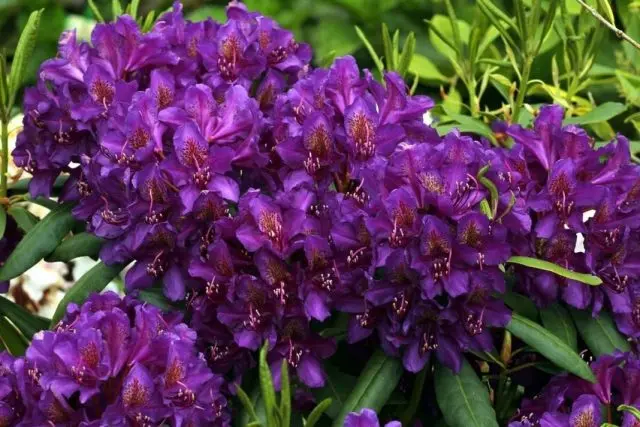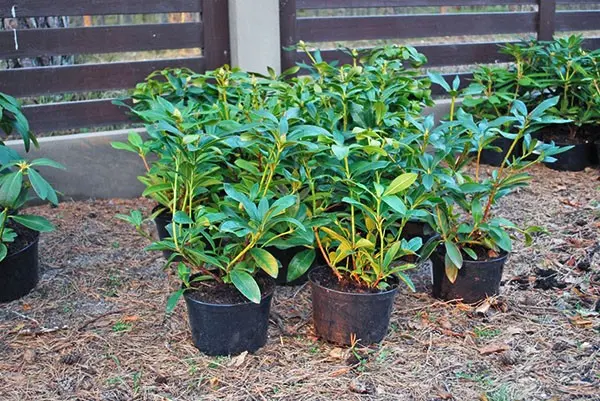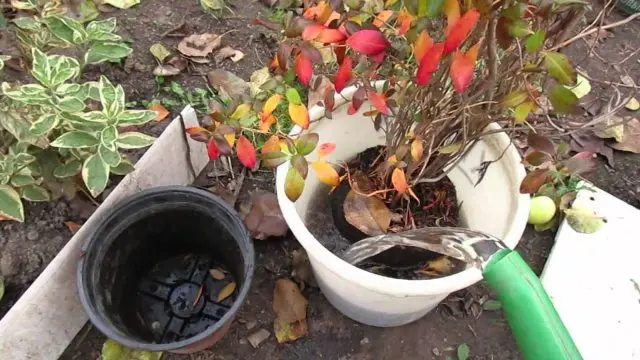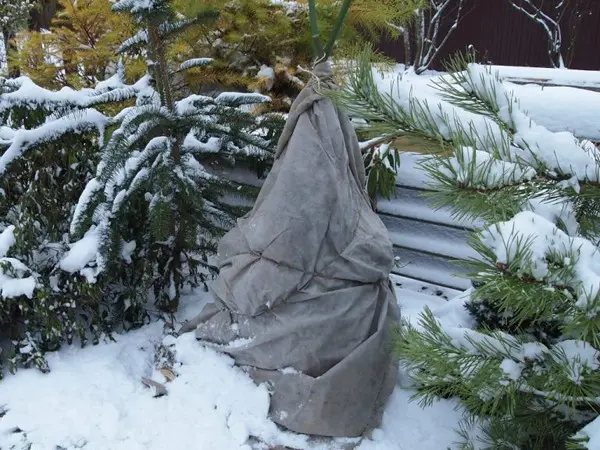Contents
Rhododendron Rasputin is a medium-sized evergreen shrub. Differs in abundant flowering, and the buds do not fall from the peduncles for a long time. In addition, this variety has the darkest flower color of all bred varieties.
Description of the Rasputin rhododendron variety
This is a hybrid variety that, under favorable conditions, can grow up to 1,5 m in height. The diameter of the shrub is on average 1,2-1,6 m. As can be seen in the photo below, the color of the buds of the Rasputin rhododendron varies from pale lilac to purple tones with a burgundy tint and raspberry blotches. The flowers form dense, rather large inflorescences.
Flowering in the Rasputin variety begins in late May-early June. The aroma is inexpressive, weak. Rhododendron fruits are neat boxes with seeds that ripen by autumn.
The leaves of the shrub are large, slightly elongated. Their length reaches 15 cm. The surface of the leaf plate is glossy, but dense. The outside is dark green, but the leaves are lighter on the inside. With the onset of cold weather, the Rasputin rhododendron does not shed its leaves, but turns brown, acquiring a golden brown shade of foliage.
The root system of the variety is superficial and rather compact. Shoots are strong, upright. The bush grows freely and spreading.

Frost resistance of rhododendron Rasputin
The winter hardiness of the Rasputin hybrid rhododendron is good, it is a frost-resistant variety. The plant survives temperatures down to -28 ° C without negative consequences.
The shrub, on the contrary, does not tolerate heat well if it grows in the open sun. Under conditions of light shading and regular spraying, the Rasputin variety can withstand temperatures up to + 29-30 ° C.
Growing conditions for hybrid rhododendron Rasputin
Rasputin evergreen rhododendron is usually placed in the shade of residential buildings or a fence. In addition, it is recommended to adhere to the following tips when growing shrubs:
- The Rasputin variety is unpretentious, but it is better to plant in loose soils rich in humus.
- If the groundwater in the site chosen for planting is located too close to the surface of the earth, it is necessary to equip the bed on a hill in this place.
- It is important to consider the neighborhood with other plants. The best neighbors for the Rasputin variety: larch, pine, oak. Despite the fact that these trees have a powerful root system, it goes deep, so they do not have competition for resources with the rhododendron. The most unfavorable neighborhood: alder, poplar, chestnut, elm, linden, willow.
- Rhododendron Rasputin loves semi-shady places, but you can land it in open areas. The most important thing is to water the plant abundantly in the sun.
Planting and caring for rhododendron Rasputin
The agricultural technique of growing rhododendron is very simple – it is unpretentious and resistant to adverse weather conditions, and also does not need frequent treatments against pests. Shrub care includes the most basic procedures:
- watering;
- fertilizing;
- pruning;
- shelter for the winter of young plants.
It is impossible to loosen the soil around the bush, let alone dig it up. The root system of the Rasputin variety lies too close to the surface, it is easy to damage it when loosening. All weeds are removed manually.

Selection and preparation of the landing site
Rhododendron Rasputin is undemanding to the type of soil. It thrives well in almost all soil types, but is best suited to well-drained, fertile areas with high levels of acidity. Before planting, the plants dig up a place for it and add a nutrient mixture of pine litter, loam and acidic high-moor peat, taken in equal proportions, to the soil.
Site preparation also consists in the fact that water is drained at the planting site – the Rasputin variety does not tolerate stagnant moisture.
Seedling preparation
A rhododendron seedling does not need additional processing before planting, however, in most cases, planting material is sold in special containers. Such storage is fraught with some complications.
The fact is that under container conditions, the root system of the rhododendron begins to die off when the ends of the roots stumble upon an obstacle in the form of a pot wall. If the container with the seedling has stagnated in the gardening store, the dead roots form a fairly dense “crust” around the active part of the root system. Thus, transplanting rhododendron into open ground does not change the situation much – the plant is still limited in growth and does not receive nutrients from the soil, since its root system is now in a container of natural origin.
Such starvation can lead to the death of the rhododendron. In order to prevent this from happening, before deepening the seedling, its root ball is slightly cut or gently “loosened” it, and the dense crust is removed.
Rules of landing
Rasputin rhododendron is planted according to the following scheme:
- An earthen ball of a seedling is dipped in a container of water for 15 minutes to soften it.
- On the prepared site, they dig a landing hole with a depth of about 60 cm and a diameter of 50 cm.
- A drainage layer of broken brick or gravel and sawdust is placed at the bottom of the pit.
- From above, a small hill is formed from the soil mixture. The roots of the seedling are spread along its slopes.
- The root system of the rhododendron is carefully sprinkled with earth to the level of the root neck, after which the near-stem circle is lightly tamped.
- The planting procedure is completed by abundant watering and mulching with spruce branches or sawdust.

Watering and top dressing
Water the Rasputin rhododendron regularly, but moderately. In conditions of extreme heat, it is recommended to spray the bushes daily. In general, about 1 liters of water are consumed per plant in summer, 10 times a week, while only warm, settled water can be used. Additionally, you can slightly acidify it by adding a small amount of peat the day before watering.
The Rasputin variety does not particularly need fertilizers, but responds well to top dressing. The following fertilizers are best suited for this horticultural crop:
- rotted manure;
- horn flour;
- ammonium sulfate;
- magnesium sulfate;
- superphosphate;
- potassium phosphate;
The first time the rhododendron is fed in the spring, the last – in July. Every time before applying fertilizer to the soil, the plant must be watered.
Organics are used in the form of liquid top dressing. They take rotted cow dung, mix it with water in a ratio of 1:15 and insist for 2-3 days.
Mineral components are diluted in low concentration, about 1:1000. It is best to use this rhododendron fertilizer scheme:
- Before flowering, nitrogen-containing fertilizers are applied to the soil: ammonium sulfate (50 g), magnesium sulfate (50 g) per 1 m2.
- After flowering, the rhododendron is fed as follows: ammonium sulfate (40 g) and superphosphate (20 g) per 1 m2.
Trimming
Rasputin rhododendron is cut off only if the bush grows strongly, which happens infrequently. As a rule, its shoots themselves form the correct silhouette of a shrub.
If pruning is still needed, then this should be done in early spring, before the start of sap flow. All sections are subsequently necessarily treated with garden pitch.
Old rhododendrons are cut so that the height of the branches is no more than 40 cm above the ground.
Preparation for winter
Despite the fact that the Rasputin rhododendron is classified as a winter-hardy variety, it is recommended to cover it with dry coniferous spruce branches or burlap for the winter. In early spring, the shelter is removed in stages, protecting the leaves from intense sun burns.
If the autumn turns out to be dry, the rhododendron is watered abundantly – 10-12 liters for each bush. If autumn, as usual, with rains, then you will not have to water the rhododendrons. By November, each bush is insulated in the root zone, laying a layer of peat around the trunk circle.

Reproduction
Rhododendron Rasputin can be propagated in almost all available ways:
- cuttings;
- seeds;
- layering.
The seed method is the most unpopular due to its laboriousness and significant time costs. Basically, rhododendron is propagated by cuttings – this method allows you to get a large amount of planting material at a time.
The cuttings are prepared as follows:
- In the first days of August, young shoots are cut from the rhododendron and divided into cuttings of 6-7 cm.
- The lower part of the cuttings is cleaned of leaves and bark.
- Then the stripped end of the planting material is lowered into any growth stimulator. Kornevin is well suited for these purposes.
- After that, the stalk is buried slightly at an angle into the substrate by 2 m.
- Planting material is watered, covered with plastic wrap and removed in the shade. Containers with cuttings are kept in a greenhouse, which must be ventilated at least once a day.
- In a month, the cuttings will form a full-fledged root system. In the spring they are transplanted to a permanent place.
Diseases and pests
Rhododendron Rasputin rarely gets sick, but sometimes plantings are affected by a fungus when the roots of the plant are flooded with heavy rainfall or excess moisture accumulates in the soil after watering. In this case, the shrub is restored with the help of Bordeaux liquid, which is sprayed with the shoots and leaves of the plant.
Of the pests, only bedbugs and rhododendron mites pose a serious danger to the Rasputin variety. It is not difficult to get rid of them – the rhododendron is treated with a soap or tobacco solution.
Conclusion
Rhododendron Rasputin is an evergreen, unpretentious shrub that can safely withstand fairly low temperatures. This quality allows you to easily grow it on the territory of most of the country, without fear that the plant will freeze in winter. Caring for a rhododendron is simple and includes basic procedures that even a beginner in gardening can handle.
For more information about the features of growing rhododendron, see here:









